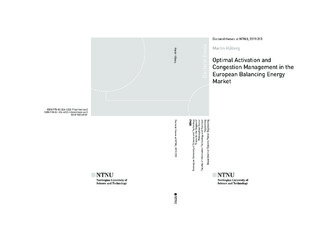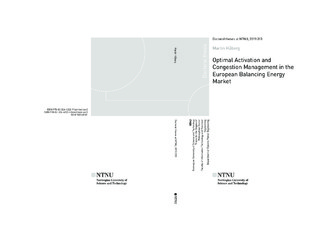| dc.contributor.advisor | Farahmand, Hossein | |
| dc.contributor.author | Håberg, Martin | |
| dc.date.accessioned | 2020-01-13T14:02:14Z | |
| dc.date.available | 2020-01-13T14:02:14Z | |
| dc.date.issued | 2019 | |
| dc.identifier.isbn | 978-82-326-4223-6 | |
| dc.identifier.issn | 1503-8181 | |
| dc.identifier.uri | http://hdl.handle.net/11250/2636029 | |
| dc.description.abstract | At the heart of the electricity system, a System Operator (referred to as Transmission System Operator (TSO) in Europe) faces the crucial task of coordinating the continuous balance between generation and consumption. Using forecasts and measurements, the TSO counteracts an imbalance by instructing flexible generators or consumers to deliver balancing energy by increasing or decreasing their level of generation or consumption. In some European countries, the TSO minimizes the cost of balancing the system through an organized balancing energy market, where service providers compete by offering balancing energy in one direction or the other as a product, at a price.
Aiming to increase efficiency, competition and security of supply, these markets are in the process of integration. For all their differing views and operational practices, European TSOs are now jointly developing new market platforms to facilitate exchange of balancing energy, and are facing consequential design decisions. The centerpiece of each balancing platform is the Activation Optimization Function (AOF), where balancing energy bids are selected for activation to satisfy the balancing demands of all TSOs. Standard products, with certain technical characteristics agreed on by TSOs, will be used for balancing energy exchange.
This thesis addresses the design of the integrated European balancing energy market. Centering around the process of activating balancing energy, it aims to identify designs that allow efficient utilization of different balancing resources and avoids congestion in the transmission network. The research includes analyses of design elements proposed for the balancing platforms under development, as well as methodological contributions representing alternative designs of the market optimization and related processes.
A set of new model formulations are presented for activation of balancing energy, focusing especially, but not exclusively on mFRR. In contrast to traditional market clearing formulations, these models are capable of optimizing activation of multiple balancing products, with different characteristics. Here, activation schedules are created for each individual bid over a scheduling horizon, with a number of operational constraints ensuring feasible activation patterns for each product. This approach augments competition to incorporate not only bid prices and locations, but also their technical characteristics.
The thesis demonstrates models for proactive TSOs to coordinate the interplay between products, giving advice on what balancing volumes to defer to a later process, closer to real time. In addition to a deterministic strategy based on alternative costs, a stochastic activation model formulation provides particularly interesting results. By taking imbalance uncertainty into account, balancing resources are utilized more efficiently, shifting activation volumes toward more flexible balancing products, and reducing balancing costs under imperfect imbalance forecasts.
Balancing energy activations and exchange impacts power flows in the transmission network, and the proposed zonal market structure requires intra-zonal congestion to be handled in an external process. With inadequate time for redispatch after balancing energy bids have been selected, TSOs must resort to determine, before the fact, which balancing energy bids could lead to congestion if activated. The thesis provides a generalized method to pre-filter bids, taking into account a range of possible balancing energy exchange situations. Another methodological contribution is the new, complementary concept of exchange domains, preventing infeasible balancing exchange situations by imposing additional constraints in the balancing optimization. Regardless of its implementation, the concept of pre-filtering bids is found to be fundamentally inefficient, detrimental to market participants and incapable of preventing congestion in certain cases.
Acknowledging these shortcomings of zonal activation models in the balancing timeframe, approaches to take intra-zonal congestion into account within the market optimization are also considered. As an alternative to purely zonal and nodal markets, this thesis presents a distributed balancing model. While keeping an overarching zonal structure, the decoupling of individual zones enables dispatch autonomy, thereby allowing nodal and zonal formulations in the same market clearing. Going forward, TSOs should pursue opportunities to improve both efficiency and operational security by incorporating transmission limitations in balancing decisions. | nb_NO |
| dc.language.iso | eng | nb_NO |
| dc.publisher | NTNU | nb_NO |
| dc.relation.ispartofseries | Doctoral theses at NTNU;2019:313 | |
| dc.relation.haspart | Paper 1: Håberg, Martin; Doorman, Gerard L.. Classification of balancing markets based on different activation philosophies: Proactive and reactive designs. International Conference on the European Energy Market 2016 ;Volum 2016-July
https://doi.org/10.1109/EEM.2016.7521272 | nb_NO |
| dc.relation.haspart | Paper 2: Håberg, Martin André Hystad; Doorman, Gerard L.. Proactive Planning and Activation of manual reserved in sequentially cleared balancing markets. I: IEEE Electrical Power and Energy Conference (EPEC) 2017. IEEE conference proceedings 2017 ISBN 978-1-5386-0817-3. s.
https://doi.org/10.1109/EPEC.2017.8286186 | nb_NO |
| dc.relation.haspart | Paper 3: Håberg, Martin; Doorman, Gerard L.. Optimal Activation of Standard Products for Balancing as Required by Draft ENTSO-E Network Codes. Cigre; 2016-11-02 - 2016-11-03 | nb_NO |
| dc.relation.haspart | Paper 4: Håberg, Martin; Doorman, Gerard L.. A Stochastic mixed integer linear programming formulation for the balancing energy activation problem under uncertainty. I: 12th IEEE Power and Energy Society PowerTech Conference PowerTech Manchester 2017. IEEE Press 2017 ISBN 978-1-5090-4238-8. s.
http://doi.org/ 10.1109/PTC.2017.7980980 | nb_NO |
| dc.relation.haspart | Paper 5: Bøe, Jonas; Håberg, Martin André Hystad; Doorman, Gerard L.. Multi-Area Balancing Energy Activation Optimization using ENTSO-E Standard Products. I: 2018 IEEE PES Innovative Smart Grid Technologies Conference Europe (ISGT-Europe).
https://doi.org/10.1109/ISGTEurope.2018.8571615 | nb_NO |
| dc.relation.haspart | Paper 6: Håberg, Martin André Hystad; Bood, Hanna; Doorman, Gerard L.. Preventing internal congestion in an integrated European balancing activation optimization. Energies 2019 ;Volum 12.(3)
https://doi.org/10.3390/en12030490
This article is an open access
article distributed under the terms and conditions of the Creative Commons Attribution
(CC BY) license (http://creativecommons.org/licenses/by/4.0/). | nb_NO |
| dc.relation.haspart | Paper 7: Håberg, Martin André Hystad; Doorman, Gerard L.. Distributed balancing energy activitation and exchange optimisation. IET Generation, Transmission & Distribution 2019 ;Volum 13 lss.(18) s. 4150-4157
http://dx.doi.org/10.1049/iet-gtd.2018.6819
This is an open access article published by the IET under (CC BY-NC 4.0) | nb_NO |
| dc.title | Activation Optimization and Congestion Management in the European Balancing Energy Market | nb_NO |
| dc.type | Doctoral thesis | nb_NO |
| dc.subject.nsi | VDP::Technology: 500::Electrotechnical disciplines: 540::Electrical power engineering: 542 | nb_NO |

